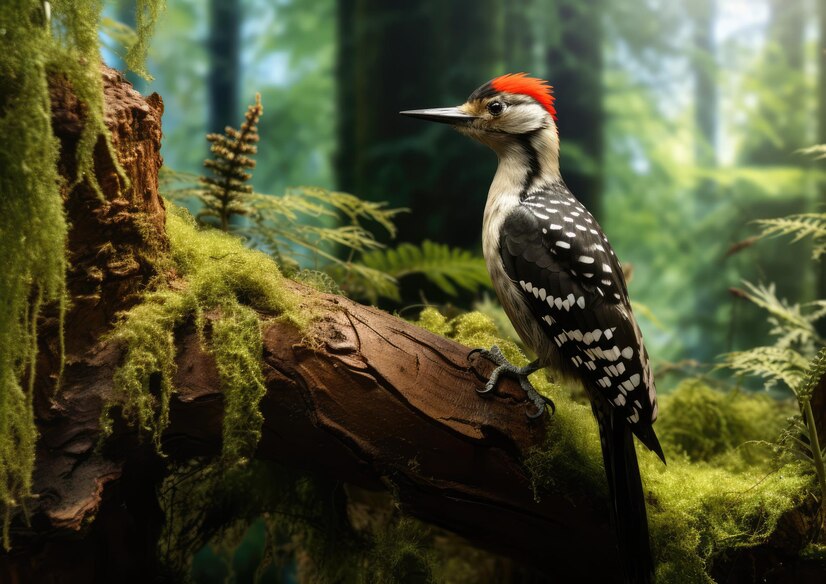Welcome to the enchanting world of Michigan woodpeckers! These vibrant and fascinating birds bring life to the forests with their rhythmic drumming and distinctive calls. Join us on a journey through the diverse woodpecker species that call Michigan home, from the iconic Pileated Woodpecker to the elusive Black-backed Woodpecker. Let’s explore their habitats, behaviors, and migration patterns in this captivating blog post dedicated to the magnificent Michigan woodpeckers.
Common Woodpecker Species in Michigan
Michigan is home to a variety of woodpecker species, each with its own distinct characteristics and behaviors. The Downy Woodpecker is a frequent visitor to backyard feeders, easily recognizable by its small size and black-and-white plumage. Red-bellied Woodpeckers are known for their striking red caps that often catch the eye as they flit among the trees.
The Northern Flicker stands out with its unique markings and ground-feeding habits, making it a common sight in open woodlands throughout Michigan. Hairy Woodpeckers share similarities with Downy Woodpeckers but boast larger sizes and longer bills.
The impressive Pileated Woodpecker, with its vibrant red crest and large size, commands attention as it searches for insects in dead wood. The striking Red-headed Woodpecker sports bold colors of red, white, and black that make it stand out against the green foliage.
Yellow-bellied Sapsuckers may be less conspicuous but play an essential role in the ecosystem by drilling holes in trees to access sap. Black-backed Woodpeckers are more elusive inhabitants of Michigan’s boreal forests, blending into their surroundings with their dark plumage while foraging for food.
Downy Woodpecker
One of the most common woodpecker species you can find in Michigan is the Downy Woodpecker. These petite birds are easily recognizable by their black and white plumage, with males sporting a small red patch on the back of their heads. Despite their small size, Downy Woodpeckers are skilled at drumming on trees to communicate and establish territory.
These versatile birds can be found in various habitats across Michigan, from urban parks to wooded areas. They have a diverse diet that includes insects, seeds, and fruits. Downy Woodpeckers are known for their distinctive “pik” call that echoes through the forest as they search for food.
If you’re lucky enough to spot a Downy Woodpecker in your backyard or while hiking in Michigan’s forests, take a moment to appreciate these charming little birds’ beauty and resourcefulness.
Red-bellied Woodpecker
The Red-bellied Woodpecker is a striking bird with a misleading name. Despite its moniker, the red on its belly is actually quite faint and often not visible in the field. What does stand out are its vibrant red head and back, making it easy to spot against the backdrop of Michigan’s forests.
These woodpeckers are skilled foragers, using their strong bills to drill into trees in search of insects and sap. They also have a unique habit of storing food in crevices for later consumption.
With their distinctive call that sounds like “churr-churr-churr,” Red-bellied Woodpeckers can be heard throughout Michigan’s wooded areas all year round. Their adaptability to various habitats, from forests to urban parks, makes them a common sight for birdwatchers across the state.
Keep an eye out for these colorful birds next time you’re out exploring Michigan’s natural beauty!
Northern Flicker
The Northern Flicker is a striking woodpecker species commonly found in Michigan. With its vibrant yellow plumage and distinctive markings, this bird stands out among the trees. Unlike other woodpeckers, the Northern Flicker often forages on the ground for insects like ants and beetles, using its slightly curved bill to probe into the soil.
One of the unique features of this woodpecker is its habit of drumming on metal objects like gutters or chimneys to communicate with other flickers. It’s fascinating to hear their rhythmic tapping echoing through the forest. During courtship displays, male flickers will perform elaborate aerial shows to attract females, showcasing their impressive wing patterns.
Whether you spot a Northern Flicker perched high in a tree or searching for food on the ground, it’s always a delightful sighting that adds color and charm to Michigan’s woodlands.
Hairy Woodpecker
The Hairy Woodpecker, a common sight in the forests of Michigan, is known for its striking black and white plumage. With a distinctive long, chisel-like bill, this woodpecker uses it to hammer into trees in search of insects and larvae hidden beneath the bark. The drumming sound they create can be heard echoing through the woods as they forage for their next meal.
These birds are skilled climbers, using their strong tail feathers and feet with sharp claws to move effortlessly up tree trunks and branches. Their presence adds a rhythmic touch to the forest ambiance as they tap away at various surfaces in their territory.
Hairy Woodpeckers are territorial creatures, often defending their chosen nesting sites fiercely from other birds and predators. During breeding season, males perform elaborate drumming displays on resonant objects to attract mates–a mesmerizing sight for birdwatchers lucky enough to witness it firsthand.
Spotting a Hairy Woodpecker among the trees is like catching a glimpse of nature’s own percussionist at work–a true marvel of Michigan’s diverse avian population.
Pileated Woodpecker
The Pileated Woodpecker is a striking bird that can be found in the forests of Michigan. With its vibrant red crest and large size, it’s hard to miss this impressive species as it hammers away at trees in search of insects. Known for its distinctive loud drumming sound, the Pileated Woodpecker is both a visual and auditory treat for birdwatchers.
These woodpeckers have strong bills that they use to excavate deep holes in search of their next meal. Their diet consists mainly of ants and beetle larvae found within the wood of trees. Watching a Pileated Woodpecker effortlessly peeling back bark with precision is truly fascinating.
Despite their large size, these birds are skilled fliers and can navigate through dense forest canopies with ease. Their unmistakable call resonates through the woods, adding an element of wildness to Michigan’s natural landscapes where they reside.
Red-headed Woodpecker
The Red-headed Woodpecker, with its striking appearance of a bright red head contrasting against a black and white body, is truly a sight to behold in Michigan’s woodlands. These medium-sized woodpeckers are known for their acrobatic flying skills and distinctive calls that echo through the forest.
Red-headed Woodpeckers have an eclectic diet, feeding on insects, fruits, nuts, seeds, and even small vertebrates. They are skilled at catching insects mid-air or storing food by impaling it on branches for later consumption.
These vibrant birds can be found in open woodlands, parks, orchards, and along riversides where they nest in tree cavities excavated by both the male and female partners. They are territorial creatures who fiercely defend their nesting sites from intruders.
During migration seasons or harsh winters when food becomes scarce in Michigan, some Red-headed Woodpeckers may venture southward seeking more abundant resources to sustain themselves until they return to their familiar habitats once again.
Yellow-bellied Sapsucker
Yellow-bellied Sapsuckers, with their distinctive black and white plumage and a touch of bright red on the throat, are quite the eye-catcher among Michigan’s woodpeckers. These medium-sized birds have a unique feeding habit compared to other woodpecker species – they feed on sap by drilling neat rows of shallow holes in trees to let the sap flow out.
Their diet not only includes sap but also insects attracted to it, making them efficient hunters while enjoying a sweet treat. Their migratory pattern adds an element of mystery as they travel south for winter, unlike some resident Michigan woodpeckers.
Despite being named “Yellow-bellied,” these birds actually have pale yellow bellies that may be difficult to spot from afar. Keep an eye out for these fascinating creatures when exploring Michigan’s forests – you might just catch a glimpse of this elusive sapsucker in action!
Black-backed Woodpecker
The Black-backed Woodpecker, a striking species found in Michigan’s forests, is known for its distinctive black plumage with white spots. This woodpecker has a preference for burned or recently disturbed areas where it can find beetle larvae under the bark of trees. With its specialized diet and habitat choice, the Black-backed Woodpecker plays a crucial role in ecosystem health by helping to control insect populations.
Unlike some other woodpeckers, the Black-backed Woodpecker does not drum on trees as frequently; instead, it uses its strong bill to pry off bark and access its prey. Its unique feeding habits make it an intriguing bird to observe in the wild. If you’re lucky enough to spot one during your outdoor adventures in Michigan’s forests, take a moment to appreciate this fascinating and elusive woodpecker species that contributes uniquely to the biodiversity of our state’s ecosystems.
Understanding Michigan Woodpeckers
Michigan woodpeckers are a diverse group of birds that can be found across the state, each with unique characteristics and behaviors. From the small Downy Woodpecker to the impressive Pileated Woodpecker, these birds play a vital role in Michigan’s ecosystem.
Commonly spotted species like the Red-bellied Woodpecker and Hairy Woodpecker can often be seen in wooded areas or visiting backyard feeders. On the other hand, rare sightings of species like the Black-backed Woodpecker add excitement to birdwatching adventures.
Understanding their habitat preferences and behavior patterns is key to spotting these elusive birds in the wild. Whether drumming on trees for communication or excavating nests in dead wood, each species has its own distinctive habits.
Migration patterns also play a significant role in when and where different woodpeckers can be observed throughout the year. Some may stay resident all year round while others migrate south for winter.
By observing and learning about Michigan woodpeckers, we gain a deeper appreciation for these fascinating avian residents of our forests.
Common vs. Rare Species
Michigan is home to a variety of woodpecker species, some more common than others. Among the most frequently seen woodpeckers in the state are the Downy Woodpecker, Red-bellied Woodpecker, and Northern Flicker. These birds can often be spotted in backyards, parks, and wooded areas across Michigan.
On the other hand, there are rare woodpecker species that bird enthusiasts hope to catch a glimpse of. The Black-backed Woodpecker and Red-headed Woodpecker fall into this category, with sightings considered special due to their elusive nature.
While encountering common woodpeckers may be relatively easy for Michiganders who keep an eye out for them during hikes or birdwatching sessions, spotting one of the rarer species requires patience and a bit of luck. Each woodpecker brings its own unique beauty and charm to Michigan’s diverse avian population.
Habitat and Behavior
Michigan woodpeckers are fascinating creatures that can be found in a variety of habitats across the state. From dense forests to suburban neighborhoods, these birds have adapted to thrive in diverse environments.
Woodpeckers are known for their distinctive behavior of drumming on trees with their strong bills. This activity serves multiple purposes, including communication with other woodpeckers and establishing territory.
In addition to drumming, woodpeckers also use their bills to peck into tree bark in search of insects, sap, or even create nest cavities. Their unique anatomy allows them to cling onto vertical surfaces while foraging for food.
When it comes to nesting habits, Michigan woodpeckers typically excavate holes in dead or decaying trees where they raise their young. These cavities provide protection from predators and harsh weather conditions.
Understanding the habitat preferences and behavior patterns of Michigan woodpeckers offers valuable insights into these remarkable avian species living in our midst.
Migration Patterns
Michigan woodpeckers exhibit interesting migration patterns that vary among different species. Some woodpeckers, like the Downy Woodpecker and Hairy Woodpecker, are non-migratory residents in Michigan throughout the year. They can be found in the state’s forests and urban areas even during winter.
On the other hand, species like the Yellow-bellied Sapsucker may migrate south to warmer regions during colder months. These birds often travel long distances to find suitable habitats for feeding and nesting. The Red-headed Woodpecker is known for its erratic migration behavior, sometimes staying put while other times moving great distances.
Understanding these migration patterns adds depth to our appreciation of Michigan’s diverse bird population. It underscores the importance of maintaining varied habitats to support both resident and migratory woodpecker species in their natural environments.
Conclusion
As you delve into the fascinating world of Michigan woodpeckers, it becomes evident that these birds are not only beautiful but also play a crucial role in maintaining the ecological balance of their habitats. From the common Downy Woodpecker to the rare Black-backed Woodpecker, each species brings its own unique charm and characteristics to Michigan’s forests.
By understanding their behaviors, habitat preferences, and migration patterns, we can appreciate and protect these incredible birds for generations to come. Whether you’re an avid birder or simply enjoy observing nature’s wonders, exploring the diverse world of Michigan woodpeckers is sure to be a rewarding experience.
So next time you find yourself wandering through Michigan’s wooded areas, keep an eye out for these vibrant birds drumming away on tree trunks or feasting on insects. You never know what fascinating encounters with woodpeckers await you in this diverse and dynamic state!







